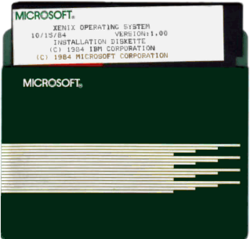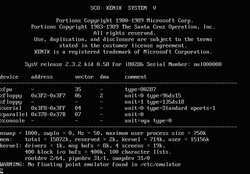- Xenix
-
Xenix
Xenix under BochsCompany / developer Microsoft OS family Unix Working state Historic Source model Closed source Initial release 1980 Latest stable release 2.3.4 / 1989 Supported platforms PC/XT, x86, PDP-11, Z8001, 68k Kernel type Monolithic kernel License Proprietary Xenix is a version of the Unix operating system, licensed to Microsoft from AT&T in the late 1970s. The Santa Cruz Operation (SCO) later acquired exclusive rights to the software, and eventually superseded it with SCO UNIX (now known as SCO OpenServer).
Contents
History
Xenix was Microsoft's version of Unix intended for use on microcomputers; because Microsoft was not able to license the "UNIX" name itself,[1] they gave it an original name.
Microsoft purchased a license for Version 7 Unix from AT&T in 1979, and announced on August 25, 1980 that it would make it available for the then-current 16-bit microcomputer market. The initial port of Xenix was to the Zilog Z8000 series and subsequently to the Intel 8086/8088 architecture ported by The Santa Cruz Operation.[2][3][4][5][6]
Xenix varied from its 7th Edition origins by incorporating elements from BSD, and soon (for a time) possessed the most widely installed base of any Unix flavor due to the popularity of the inexpensive x86 processor.
Microsoft did not sell Xenix directly to end users; instead, they licensed it to software OEMs such as Intel, Tandy, Altos and SCO, who then ported it to their own proprietary computer architectures. Microsoft Xenix originally ran on the PDP-11; the first port was for the Zilog Z8001 16-bit processor. Altos shipped a version for their Intel 8086 based computers early in 1982, Tandy Corporation shipped TRS-XENIX for their 68000-based systems in January 1983, and SCO released their port to the IBM PC in September 1983.
 IBM/Microsoft Xenix 1.00 on 5¼-inch floppy disk
IBM/Microsoft Xenix 1.00 on 5¼-inch floppy disk
A port to the 68000-based Apple Lisa also existed. At the time, Xenix was based on AT&T's UNIX System III.
Version 2.0 of Xenix was released in 1985 and was based on UNIX System V. An update numbered 2.1.1 added support for the Intel 80286 processor. The Sperry PC/IT, an IBM PC AT clone, was advertised as capable of supporting eight users under this version. Subsequent releases improved System V compatibility.
In 1987, SCO ported Xenix to the 386 processor, a 32-bit chip. Xenix 2.3.1 introduced support for i386, SCSI and TCP/IP. SCO's Xenix System V/386 was the first 32-bit operating system available on the market for the x86 CPU Architecture.
When Microsoft entered an agreement with IBM to develop OS/2, it lost interest in promoting Xenix. In 1987 Microsoft transferred ownership of Xenix to SCO in an agreement that left Microsoft owning 25% of SCO. When Microsoft eventually lost interest in OS/2 as well, it based its further high-end strategy on Windows NT.
Microsoft continued to use Xenix internally, submitting a patch to support functionality in UNIX to AT&T in 1987, which trickled down to the code base of both Xenix and SCO UNIX. Microsoft is said to have used Xenix on Sun workstations and VAX minicomputers extensively within their company as late as 1992.[7] All internal Microsoft email transport was done on Xenix-based 68000 systems until 1993.[citation needed]
In the late 1980s, Xenix was, according to The Design and Implementation of the 4.3BSD UNIX Operating System, "probably the most widespread version of the UNIX operating system, according to the number of machines on which it runs".[8]
SCO first released SCO UNIX as a higher-end product, based on System V Release 3 and offering a number of technical advances over Xenix; Xenix remained in the product line. In the meantime, AT&T and Sun Microsystems completed the merge of Xenix, BSD, SunOS and System V into System V Release 4. SCO UNIX was still based on SVR3, but had most features of Release 4. The last version of Xenix itself was 2.3.4.
Trusted Xenix
Trusted Xenix was a variant developed by Trusted Information Systems which incorporated the Bell-La Padula model of multilevel security, and had a multilevel secure interface for the STU-III secure communications device (that is, an STU-III connection would only be made available to applications running at the same privilege level as the key loaded in the STU-III).[9] It was evaluated by formal methods and achieved a B2 security rating under the DoD's Trusted Computer System Evaluation Criteria—the second highest rating ever achieved by an evaluated operating system.[10] Version 2.0 was released in January 1991, version 3.0 in April 1992, and version 4.0 in September 1993.[11] It was still in use at least until 1995.
References
- ^ "Xenix variant information". 2010-02-26. http://www.computerhope.com/unix/xenix.htm. "In the late 1970's Microsoft licensed Unix source code from AT&T, which at the time was not licensing the name Unix."
- ^ Hare, John Bruno; Thomas Dean Thomas (1984). "Porting Xenix to the Unmapped 8086". Proceedings of the USENIX Winter Conference. Washington, D.C.: USENIX Association.
- ^ "SCO Company History". Operating System Documentation Project. http://www.operating-system.org/betriebssystem/_english/fa-sco.htm. Retrieved 2008-05-14.
- ^ Bader, William. "SCO History". http://williambader.com/museum/dell/xenixhistory.html. Retrieved 2008-05-14.
- ^ Demblon, Simone. "Linux Internals". The Shuttleworth Foundation. Archived from the original on 2008-02-03. http://web.archive.org/web/20080203073225/http://learnlinux.tsf.org.za/courses/build/internals/ch01s02.html. Retrieved 2008-05-14.
- ^ Barger, Jorn. "Timeline of GNU/Linux and Unix". http://laurel.datsi.fi.upm.es/~ssoo/IG/download/timeline.html. Retrieved 2008-05-14.
- ^ Terry Lambert (2000-11-07). "Re: Microsoft Source (fwd)". sol.lists.freebsd.chat. (Web link). Retrieved 2006-10-25.
- ^ Leffler, Samuel J.; et al. (October 1989). The Design and Implementation of the 4.3BSD UNIX Operating System. Addison-Wesley. pp. 7. ISBN 0-201-06196-1.
- ^ Gligor, V.D.; Chandersekaran, C.S.; Chapman, R.S. (February 1987), "Design and Implementation of Secure Xenix", IEEE Transactions on Software Engineering SE-13 (2): 208–221, ISSN 0098-5589
- ^ Jaeger, Trent (2008). Operating System Security. Synthesis Lectures on Information Security, Privacy, and Trust. Morgan & Claypool Publishers. ISBN 9781598292121. http://books.google.com/books?id=P4PYPSv8nBMC&printsec=frontcover#v=onepage&q&f=false.
- ^ Lévénez, Éric (May 1, 2011). "Unix History". http://www.levenez.com/. http://www.levenez.com/unix/. Retrieved May 18, 2011.
External links
- German Site about the history of Xenix
- Tandy Images for Download
- Xenix documentation and books for Download
- Unsorted Xenix images, scans and photos
- Intel Multibus System 320 for Xenix (or iRMX86)
- Welcome to comp.unix.xenix.sco (v 1.64)
- XENIX -- Microsoft Short-lived Love Affair with Unix includes list of Xenix books
Operating systems by Microsoft Unix and Unix-like operating systems AIX · AmigaOS · BSD · DragonFly BSD · FreeBSD · GNU · HP-UX · IRIX · Linux · LynxOS · Mac OS X · MINIX · NetBSD · OpenBSD · Plan 9 · QNX · Research Unix · SCO OpenServer · Solaris · UNIX System V · Tru64 UNIX · UnixWare · VxWorks · Xenix · moreCategories:- Discontinued Microsoft software
- Microsoft operating systems
- System V
- Lightweight Unix-like systems
Wikimedia Foundation. 2010.

